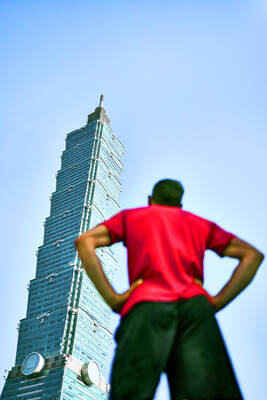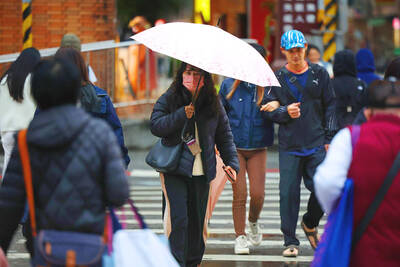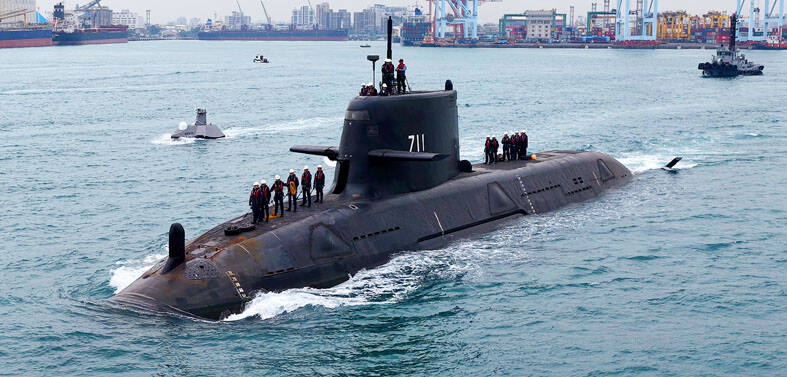The Chinese Nationalist Party’s (KMT) authoritarian regime was notorious for its mass surveillance of the public, and the omnipresence of the Taiwan Garrison Command and its secret security apparatus was a key element that invoked fear in the White Terror era within and without Taiwan.
While stories of the torments and agony suffered by those who fell into the hands of the Taiwan Garrison Command have been unearthed by historians since the nation’s democratization in 1990s, few have documented the work or impact of the command.
The passage of the Act on Promoting Transitional Justice (促進轉型正義條例) on Dec. 5 last year has brought renewed attention to the command’s use of student informers — euphemistically known as “professional students” (職業學生) — who worked as campus spies overseas for the command.
The new law requires the Executive Yuan to set up an independent committee to implement transitional justice measures specified by the law, including the retrieval of political records from political parties and affiliated organizations that are determined to be documents belonging in the national archives.
Documents from the nation-state era that are in the KMT’s possession are likely a treasure trove of historical information and a number of historians have said they hope the party will turn such papers over to the state.
Such documents could shed light on the so-called “Overseas Blacklist,” a list drawn up by the KMT regime — likely as a result of information supplied by student informants — of dissidents it did not want returning to Taiwan.
One such victim of the KMT government’s blacklist is Prospect Foundation chairman Mark Chen (陳唐山), a former Presidential Office secretary-general, foreign minister and secretary-general of the National Security Council.
Chen went to the US in 1964 to enroll in a master’s program at the University of Oklahoma. Thanks to his advocacy of Taiwanese independence, he was blacklisted from returning home for 29 years, until Article 100 of the Criminal Code, which restricted freedom of expression, was amended in 1992.
“In the river of the nation’s history spanning from the 228 Massacre, the blacklist, the Wild Lily [movement] and the Sunflower [movement] — where young people rose and challenged authorities — the blacklist era lasted the longest, and had a global reach that deeply affected Taiwan’s democratization,” Chen wrote in his autobiography, The Blacklist and Foreign Minister — Mark Chen’s Memoir (黑名單與外交部長 陳唐山回憶錄), which was published in November last year.
In a recent interview with the Taipei Times, Chen recalled the KMT’s autocratic rule.
“The authorities used the same tactics in dealing with people who had absolutely nothing to do with the communists, as we had seen in the 228 Incident. As such, many Taiwanese dared not speak out at home in Taiwan,” he said.
“We were forced to shut up when we were in Taiwan. However, since we [overseas students] were not in Taiwan anymore, but breathing the air of freedom in the US, if we did not do something to change Taiwan, we would let the people who raised and provided for us in Taiwan down,” he said. “With the conscience of intelligentsia, we had the responsibility to help make Taiwan a democracy.”
Asked why presidents Chiang Kai-shek (蔣介石) and Chiang Ching-kuo (蔣經國) thought it necessary to conduct surveillance on those overseas, Chen said: “It was because the regime was afraid that we might create a disturbance or something [challenging their authority]. So ‘professional students’ were planted on campus, mingled with us and collected information on whom, in their opinion, might revolt.”
While the Chiangs’ KMT regime denied using student informants to spy on students overseas, a slew of US media reports at the time suggested otherwise.
In a story headlined “Foreign Agencies in US Cause Concern,” published on Jan. 5, 1986, the Boston Globe reported “the US-based operations [of Taiwan’s intelligence] began in 1971 with [then US-president Richard] Nixon’s overtures to the People’s Republic of China ‘with the objective of actively countering the rise of pro-[China] groups.’”
The newspaper cited a 1978 Senate Foreign Relations Committee report as saying that after Admiral Wang Hsi-ling (汪希苓) assumed the helm of the Taiwan Garrison Command, “a much wider program was begun to monitor, infiltrate, and disrupt the US activities of Peking sympathizers and members of Taiwan independence movement.”
A Wall Street Journal story from March 8, 1982, headlined “Taiwanese Students Bring Fierce Rivalries to US Campuses,” said that “since the 1960s, students from Taiwan enrolled at ... dozens of other schools have complained of spying and harassment by fellow [the Chinese faction] who allegedly draw Taiwanese government pay for their activities.”
Taiwanese students overseas were terrified of the campus spies’ surveillance to the extent that many would not pick up pro-Taiwan independence magazines with their hands for fear of leaving fingerprints, being reported on and jeopardizing their return to Taiwan and employment opportunities, or implicating their family members, Chen said.
“People would pick up the magazines with chopsticks,” he said.
While the student informants were careful to conceal their identity, “by their actions we could feel who the professional students were,’” he said.
At the time there were two student groups for Taiwanese students, the Taiwanese Association (台灣同鄉會) and the Taiwan Benevolent Association (台灣同鄉聯誼會), with the former funded by students who supported Taiwan being a democracy, while the latter was subsidized by the KMT, Chen said.
“People from the Taiwan Benevolent Association would attend the Taiwanese Association’s meetings to watch us and noting whom among us were student leaders, because in their eyes, the ones who took part in Taiwanese association activities were the ones who harbored ‘questionable thoughts,’” Chen said. “They reported names of the students to the Taiwan Garrison Command, who would then visit the students’ parents, tell them their kids in the US ‘seemed to be having problems’ and intimidate them.”
Chen said he became an open target after he was elected head of the Taiwanese Association.
“Since the KMT authority already had me locked under its watch, there was no question of fear for me, so I went all the way to open my outreach to other Taiwanese associations in the Norman [Oklahoma] area,” he said.
Chen said being blacklisted meant his Republic of China passport was confiscated when he mailed it in 1966 for an extension; there were hurdles in his application for a visa to return home in 1974 that meant he did not get back to see his mother before she died; and a visa application to return home after his father died in 1979 was rejected.
Others who were blacklisted found they faced obstacles in trying to land a civil service position despite returning to Taiwan with a doctorate, while others were killed, such as Carnegie Mellon University associate math professor Chen Wen-chen (陳文成) at the age of 31.
Chen Wen-chen returned to Taipei on May 20, 1981, for the first time since 1975 to introduce his baby son to his parents. However, after being taken away for questioning by Taiwan Garrison Command officers on July 2, his body was found at outside a building on the National Taiwan University campus the next day.
Mark Chen, then head of the Taiwanese Association of America, visited Carnegie Mellon University president Richard Cyert to discuss Chen Wen-chen’s death, and with Cyert’s assistance, was able to get US forensic pathologist Cyril Wecht to visit Taiwan to investigate. Wecht concluded Chen Wen-chen’s death was a homicide.
Repeated appeals lodged by the Taiwanese Association of America succeeded in getting the US House of Representatives Foreign Affairs Committee’s subcommittee on Asian and Pacific affairs to hold hearings in July and October 1981 on “Taiwan Agents in America and the Death of Professor Wen-chen Chen.”
“At issue is the infiltration of American universities by informants who, directly or indirectly, report to the Taiwan government,” Representative Jim Leach, a Republican, said at one of hearings, according to the Reports for Congress by the Congressional Research Service dated May 26, 2010.
Asked how “professional students” should be viewed, Mark Chen said: “These people were spies because they received benefits in return for surveilling us.”
“It is okay if they supported the KMT, but why come and bite us? We have our freedom, why act against us?” he said.
Asked about appealing to the conscience of those who were once “professional students,” Mark Chen said he hoped that “those who had, in Taiwan or overseas, been an accessory and accomplice of the KMT can engage in introspection, since it is difficult for us to identify who they are unless they themselves openly come forward about it.”
Taiwan’s democracy was an achievement made possible by a collective effort and the sacrifices of countless people who were blacklisted and whose names might never be known, he said.
Hopefully, one day a more complete and comprehensive record of them will be documented, he said.
“That way they would not be left out of chapters of Taiwan’s history,” he said.

US climber Alex Honnold is to attempt to scale Taipei 101 without a rope and harness in a live Netflix special on Jan. 24, the streaming platform announced on Wednesday. Accounting for the time difference, the two-hour broadcast of Honnold’s climb, called Skyscraper Live, is to air on Jan. 23 in the US, Netflix said in a statement. Honnold, 40, was the first person ever to free solo climb the 900m El Capitan rock formation in Yosemite National Park — a feat that was recorded and later made into the 2018 documentary film Free Solo. Netflix previewed Skyscraper Live in October, after videos

NUMBERS IMBALANCE: More than 4 million Taiwanese have visited China this year, while only about half a million Chinese have visited here Beijing has yet to respond to Taiwan’s requests for negotiation over matters related to the recovery of cross-strait tourism, the Tourism Administration said yesterday. Taiwan’s tourism authority issued the statement after Chinese-language daily the China Times reported yesterday that the government’s policy of banning group tours to China does not stop Taiwanese from visiting the country. As of October, more than 4.2 million had traveled to China this year, exceeding last year. Beijing estimated the number of Taiwanese tourists in China could reach 4.5 million this year. By contrast, only 500,000 Chinese tourists are expected in Taiwan, the report said. The report

Temperatures are forecast to drop steadily as a continental cold air mass moves across Taiwan, with some areas also likely to see heavy rainfall, the Central Weather Administration (CWA) said. From today through early tomorrow, a cold air mass would keep temperatures low across central and northern Taiwan, and the eastern half of Taiwan proper, with isolated brief showers forecast along Keelung’s north coast, Taipei and New Taipei City’s mountainous areas and eastern Taiwan, it said. Lows of 11°C to 15°C are forecast in central and northern Taiwan, Yilan County, and the outlying Kinmen and Lienchiang (Matsu) counties, and 14°C to 17°C

STEERING FAILURE: The first boat of its class is experiencing teething issues as it readies for acceptance by the navy, according to a recent story about rudder failure The Hai Kun (海鯤), the nation’s first locally built submarine, allegedly suffered a total failure of stern hydraulic systems during the second round of sea acceptance trials on June 26, and sailors were forced to manually operate the X-rudder to turn the submarine and return to port, news Web site Mirror Daily reported yesterday. The report said that tugboats following the Hai Kun assisted the submarine in avoiding collisions with other ships due to the X-rudder malfunctioning. At the time of the report, the submarine had completed its trials and was scheduled to begin diving and surfacing tests in shallow areas. The X-rudder,